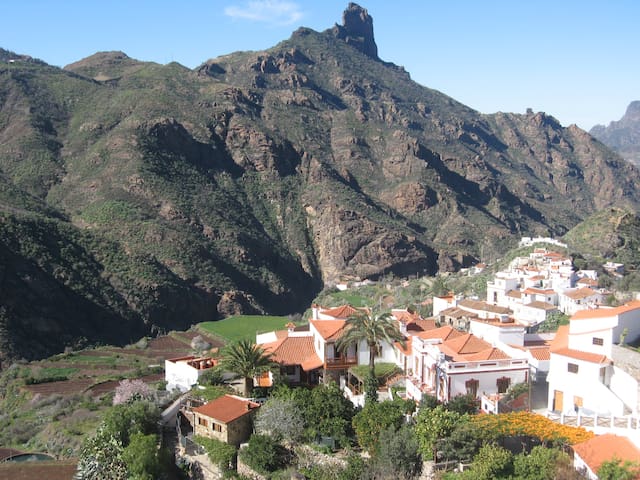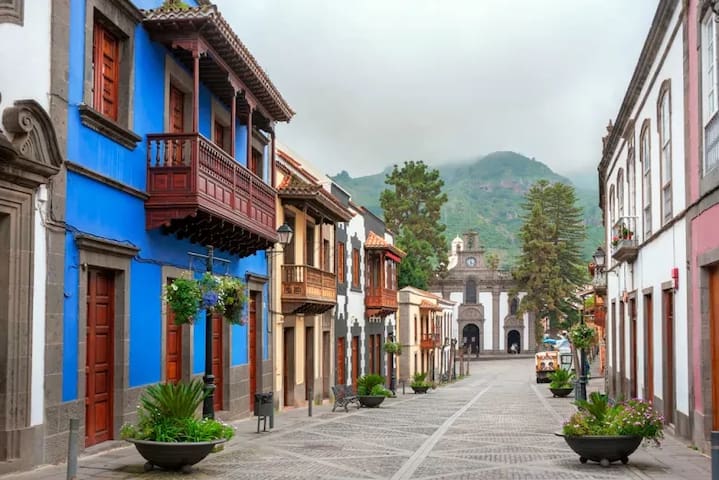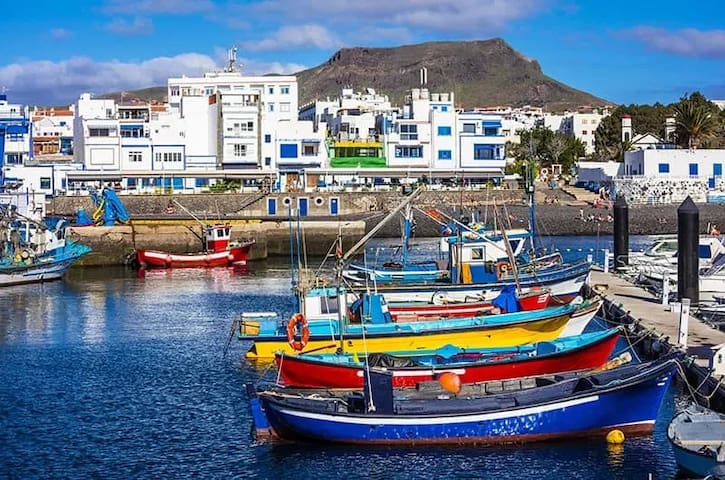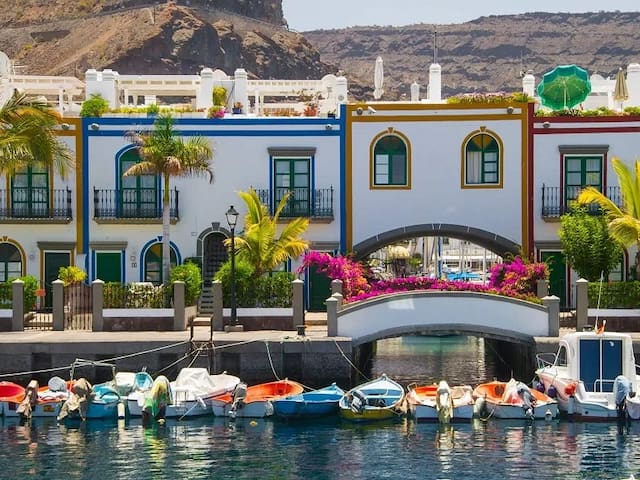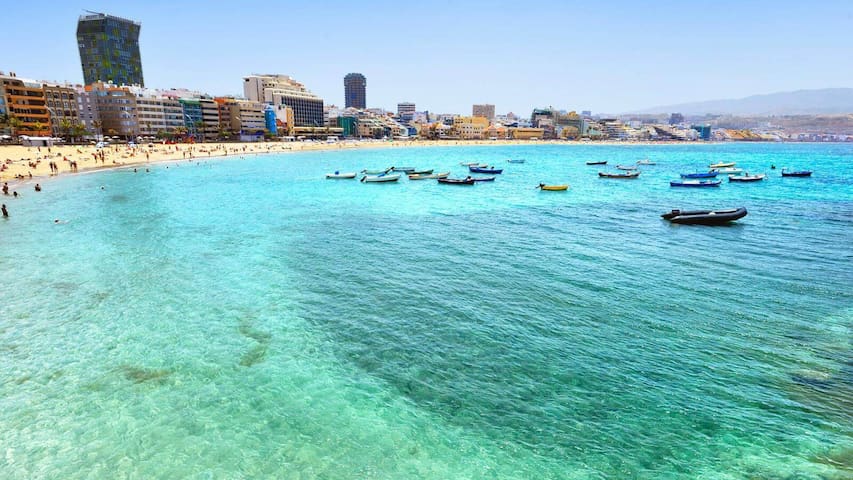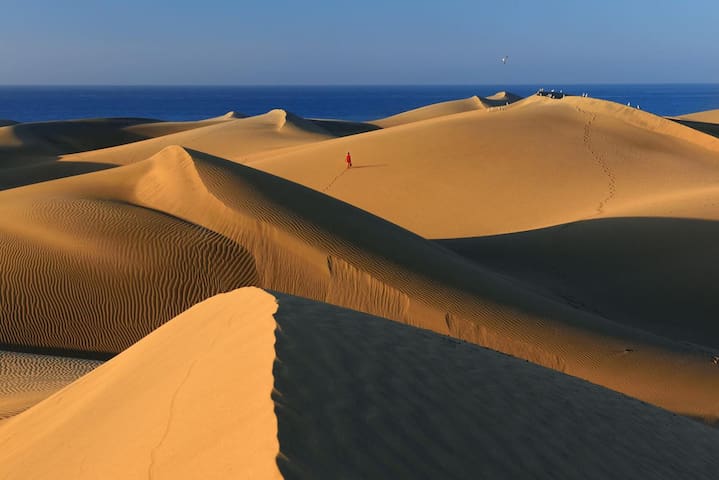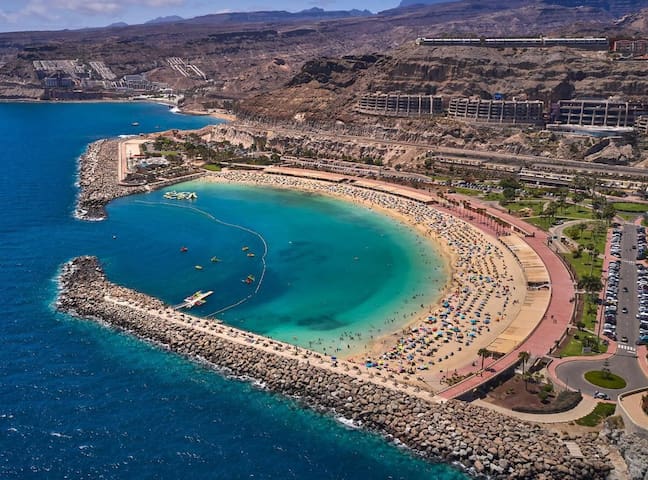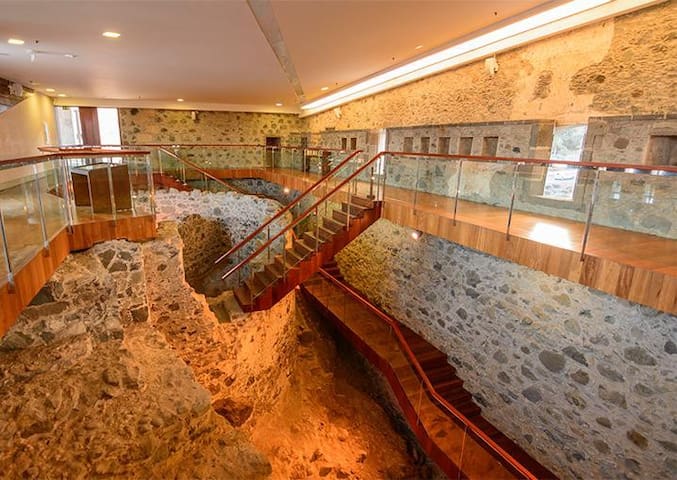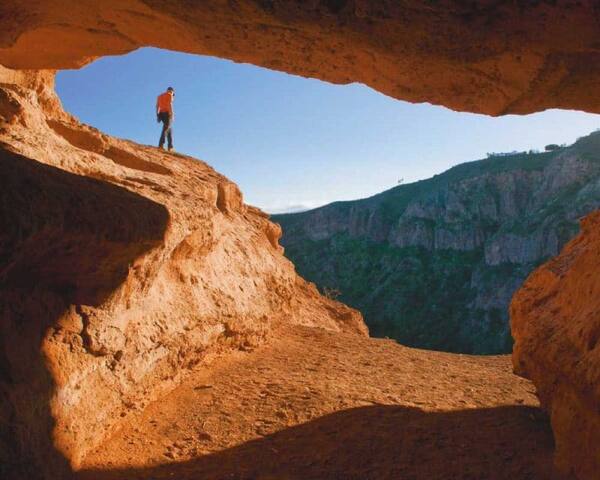Must-see
Discover one of the most beautiful villages in Spain.
Tejeda, in the central summit of Gran Canaria, tastes of almonds, a fruit on which its traditional confectionery is based. In a landscape of ravines and in the shadow of the roque Nublo, symbol of the island, this village breathes tranquility and charm. It is the ideal place for a rural getaway away from the hustle and bustle and stress, where to be seduced by the beauty of the peaks and the powerful balm of the unique nature of this area of the island.
The essence of a traditional Canarian village
As in many rural villages of the Canary Islands, the epicenter is in the church. The surrounding streets preserve sober, white-walled houses with tiled roofs. Outside there are small gardens with flower pots. This is the case of the Museum of Traditions, a building of traditional architecture where you can discover the rural way of life of the village throughout its history.
206 Einheimische empfehlen
Tejeda
Discover one of the most beautiful villages in Spain.
Tejeda, in the central summit of Gran Canaria, tastes of almonds, a fruit on which its traditional confectionery is based. In a landscape of ravines and in the shadow of the roque Nublo, symbol of the island, this village breathes tranquility and charm. It is the ideal place for a rural getaway away from the hustle and bustle and stress, where to be seduced by the beauty of the peaks and the powerful balm of the unique nature of this area of the island.
The essence of a traditional Canarian village
As in many rural villages of the Canary Islands, the epicenter is in the church. The surrounding streets preserve sober, white-walled houses with tiled roofs. Outside there are small gardens with flower pots. This is the case of the Museum of Traditions, a building of traditional architecture where you can discover the rural way of life of the village throughout its history.
A town born around the legend of the Virgin of the Pine.
Teror, in north Gran Canaria, is one of the oldest towns in the Canary Islands. Founded after the appearance of the Virgin in 1481 and declared a pilgrimage town at the ends of the 15th Century, Teror boasts a considerable religious heritage including its church, convents and the original houses of local noble families. Real de la Plaza street has been the social and commercial heart of the town for 500 years.
Spend a Sunday discovering sweet traditions and the famous chorizo.
Teror’s pastry makers and bakers are famous for their sweet treats in Gran Canaria. The Císter convent sells the town’s famous shortbread, turnovers, marzipan treats and aniseed cakes. At the nearby Finca de Osorio estate you can walk off the calories on several guided walks through nature. Teror is lively on Sunday mornings thanks to a street market in the main square that sells a wide range of local produce, jewelry and wooden and textile handicrafts, as well as typical products like the popular spreadable chorizo sausage.
193 Einheimische empfehlen
Teror
18 C. BuenavistaA town born around the legend of the Virgin of the Pine.
Teror, in north Gran Canaria, is one of the oldest towns in the Canary Islands. Founded after the appearance of the Virgin in 1481 and declared a pilgrimage town at the ends of the 15th Century, Teror boasts a considerable religious heritage including its church, convents and the original houses of local noble families. Real de la Plaza street has been the social and commercial heart of the town for 500 years.
Spend a Sunday discovering sweet traditions and the famous chorizo.
Teror’s pastry makers and bakers are famous for their sweet treats in Gran Canaria. The Císter convent sells the town’s famous shortbread, turnovers, marzipan treats and aniseed cakes. At the nearby Finca de Osorio estate you can walk off the calories on several guided walks through nature. Teror is lively on Sunday mornings thanks to a street market in the main square that sells a wide range of local produce, jewelry and wooden and textile handicrafts, as well as typical products like the popular spreadable chorizo sausage.
Agaete is a town that cannot be missing in your visit. In this beautiful municipality, you can start your tour and enjoy a pleasant day while visiting emblematic sites such as the botanical garden known as the Huerto de las Flores or the Plaza Tomás Morales.
The botanical garden is a place to connect with the splendour of nature, as you will not only be able to observe the great variety of plant species from the Canary Islands, but also from other parts of the world.
Then, when you go to the Plaza Tomás Morales, which is located in the centre of the town, you will be able to see the church of Nuestra Señora de la Concepción, surrounded by a grove of laurel trees. This square in Agaete pays homage to the famous Canarian poet Tomás Morales, who lived and practised as a doctor in the town, a place steeped in history!
221 Einheimische empfehlen
Agaete
Agaete is a town that cannot be missing in your visit. In this beautiful municipality, you can start your tour and enjoy a pleasant day while visiting emblematic sites such as the botanical garden known as the Huerto de las Flores or the Plaza Tomás Morales.
The botanical garden is a place to connect with the splendour of nature, as you will not only be able to observe the great variety of plant species from the Canary Islands, but also from other parts of the world.
Then, when you go to the Plaza Tomás Morales, which is located in the centre of the town, you will be able to see the church of Nuestra Señora de la Concepción, surrounded by a grove of laurel trees. This square in Agaete pays homage to the famous Canarian poet Tomás Morales, who lived and practised as a doctor in the town, a place steeped in history!
Family beach in Gran Canaria with easy access and calm water.
Anyone looking for a family beach will find holiday paradise at Mogán. Located in south Gran Canaria, Mogán beach is ideal for all ages and is a family favourite thanks to its white sand and tranquil water. The sand here is always full of sandcastles and children playing in the water while their parents sit in the shade of the parasols and think about joining them for a swim.
A safe beach with a family atmosphere.
Close to the sand at Mogán are shops, restaurants and outdoor cafés with views of the marina. Over 200 metres long the beach has a promenade with outdoor showers that is completely wheelchair- and pram-friendly. The beach is manned by lifeguards to make sure that everybody is safe.
119 Einheimische empfehlen
Mogán
Family beach in Gran Canaria with easy access and calm water.
Anyone looking for a family beach will find holiday paradise at Mogán. Located in south Gran Canaria, Mogán beach is ideal for all ages and is a family favourite thanks to its white sand and tranquil water. The sand here is always full of sandcastles and children playing in the water while their parents sit in the shade of the parasols and think about joining them for a swim.
A safe beach with a family atmosphere.
Close to the sand at Mogán are shops, restaurants and outdoor cafés with views of the marina. Over 200 metres long the beach has a promenade with outdoor showers that is completely wheelchair- and pram-friendly. The beach is manned by lifeguards to make sure that everybody is safe.
The cradle of authentic honey rum.
Just a short 17-km drive from the capital of Gran Canaria, lies the small municipality of Arucas. Tucked between the municipalities of Moya and Firgas to the west; Teror to the south; and Las Palmas to the east. The picturesque old quarter of the municipality’s capital dates back to the end of the 15th century, when the Spanish conquistadores completely destroyed the original pre-Hispanic settlement of Arehucas only to rebuild it around the chapel of San Juan. Today, the original church no longer stands but in its place rises the impressive Church of San Juan Bautista. Popularly known as the Arucas Cathedral, the iconic landmark is one of the architectural jewels of the Canary Islands.
A visit to Arucas is incomplete without a visit to the renowned Arehucas Rum Factory, or the surrounding banana plantations or the characteristic volcanic blue stone quarries.
121 Einheimische empfehlen
Arucas, Las Palmas
The cradle of authentic honey rum.
Just a short 17-km drive from the capital of Gran Canaria, lies the small municipality of Arucas. Tucked between the municipalities of Moya and Firgas to the west; Teror to the south; and Las Palmas to the east. The picturesque old quarter of the municipality’s capital dates back to the end of the 15th century, when the Spanish conquistadores completely destroyed the original pre-Hispanic settlement of Arehucas only to rebuild it around the chapel of San Juan. Today, the original church no longer stands but in its place rises the impressive Church of San Juan Bautista. Popularly known as the Arucas Cathedral, the iconic landmark is one of the architectural jewels of the Canary Islands.
A visit to Arucas is incomplete without a visit to the renowned Arehucas Rum Factory, or the surrounding banana plantations or the characteristic volcanic blue stone quarries.
Arguineguín is a charming fishing town in the south of Gran Canaria and one of the island’s most-visited destinations. Despite its popularity, it hasn’t lost its identity. It is the largest town in the municipality of Mogán, a cliff-lined corner of Gran Canaria that hides a multitude of beautiful beaches.
The Port of Arguineguín is just like it was in the old days – think traditional fishing boats painted in cheery colours coming into port every day filled with different species of tuna. That said, the town has been savvy enough to move with the times and now combines the charm of a traditional fishing port with the facilities of a marina.
29 Einheimische empfehlen
Arguineguín
Arguineguín is a charming fishing town in the south of Gran Canaria and one of the island’s most-visited destinations. Despite its popularity, it hasn’t lost its identity. It is the largest town in the municipality of Mogán, a cliff-lined corner of Gran Canaria that hides a multitude of beautiful beaches.
The Port of Arguineguín is just like it was in the old days – think traditional fishing boats painted in cheery colours coming into port every day filled with different species of tuna. That said, the town has been savvy enough to move with the times and now combines the charm of a traditional fishing port with the facilities of a marina.
Sightseeing
One of the top Urban Beaches in Europe.
Las Canteras beach in northeast Gran Canaria, right in the capital city Las Palmas, is amongst Europe’s most famous city beaches. It’s appeal is due to its natural beauty, city-centre location and the services and amenities along its promenade. At Las Canteras beach you get calm waters and warm weather all year round: Its natural offshore lava reef acts as a wavebreak and protects the sand and the exuberant marine life that make Las Canteras a top snorkeling spot.
A golden sand beach in Las Palmas de Gran Canaria.
Las Canteras is an ideal beach for long barefoot walks as it’s golden sand stretches for over two kilometres. during the day you can sunbathe by the sand sculptures, rent parasols and loungers or surf at the southern end. Children love Las Canteras thanks to its clear, calm waters, playgrounds and sports zones. The beach is also accessible to all and has parking, changing rooms and showers. At sunset its beachfront terraces fill up and the promenade’s cafés, bars and restaurants are lively into the night.
10 Einheimische empfehlen
Paseo las Canteras
Paseo las CanterasOne of the top Urban Beaches in Europe.
Las Canteras beach in northeast Gran Canaria, right in the capital city Las Palmas, is amongst Europe’s most famous city beaches. It’s appeal is due to its natural beauty, city-centre location and the services and amenities along its promenade. At Las Canteras beach you get calm waters and warm weather all year round: Its natural offshore lava reef acts as a wavebreak and protects the sand and the exuberant marine life that make Las Canteras a top snorkeling spot.
A golden sand beach in Las Palmas de Gran Canaria.
Las Canteras is an ideal beach for long barefoot walks as it’s golden sand stretches for over two kilometres. during the day you can sunbathe by the sand sculptures, rent parasols and loungers or surf at the southern end. Children love Las Canteras thanks to its clear, calm waters, playgrounds and sports zones. The beach is also accessible to all and has parking, changing rooms and showers. At sunset its beachfront terraces fill up and the promenade’s cafés, bars and restaurants are lively into the night.
Where Las Palmas de Gran Canaria was born.
Towards the south of Gran Canaria’s capital city, Vegueta was the original settlement that gave birth to Las Palmas de Gran Canaria at the end of the 15th Century. Its streets and squares contain historical buildings such as the Casa de Colon mansion, Santa Ana cathedral, the Museo Canario museum, Gabinete Literario club, Casas Consistoriales and Centro Atlántico de Arte Moderno gallery. The area around the market, built in 1856, is full of shops and over the road is the Triana shopping district.
An historic old town full of culture and pretty corners.
Alongside the Guiniguada barranco and opposite the Perez Galdós theatre, named after a famous Vegueta resident, you find an old town full of cobbled streets, pretty corners and a wide range of architectural styles ranging from late Gothic to renaissance. After a walk there are plenty of outdoor terraces to enjoy a break and absorb the atmosphere of its historical surroundings.
255 Einheimische empfehlen
Vegueta
Where Las Palmas de Gran Canaria was born.
Towards the south of Gran Canaria’s capital city, Vegueta was the original settlement that gave birth to Las Palmas de Gran Canaria at the end of the 15th Century. Its streets and squares contain historical buildings such as the Casa de Colon mansion, Santa Ana cathedral, the Museo Canario museum, Gabinete Literario club, Casas Consistoriales and Centro Atlántico de Arte Moderno gallery. The area around the market, built in 1856, is full of shops and over the road is the Triana shopping district.
An historic old town full of culture and pretty corners.
Alongside the Guiniguada barranco and opposite the Perez Galdós theatre, named after a famous Vegueta resident, you find an old town full of cobbled streets, pretty corners and a wide range of architectural styles ranging from late Gothic to renaissance. After a walk there are plenty of outdoor terraces to enjoy a break and absorb the atmosphere of its historical surroundings.
Desert and oasis in south Gran Canaria.
The Maspalomas Dune system is a unique wild place in the Canary Islands due to its beauty and range of ecosystems. Its 400 hectares, protected by the Canarian government as a Nature Reserve of special value, include a fantastic beach, a dynamic sand dune system, palm grove and a brackish lagoon. This mix of desert and oasis is at the southern tip of Gran Canaria and is surrounded by the famous Maspalomas resort.
What to do in the Maspalomas dunes.
To learn more about the area visit the information centre and lookout point in the Hotel Riu Palace in Playa del Inglés in northeast Maspalomas. From here take fork number three of the trail through all the different types of dune in the reserve and down to sunny Maspalomas beach. From the beach you can see the abundant wildlife in the lagoon and relax in the shade of the palm grove.
103 Einheimische empfehlen
Praia de Maspalomas
Desert and oasis in south Gran Canaria.
The Maspalomas Dune system is a unique wild place in the Canary Islands due to its beauty and range of ecosystems. Its 400 hectares, protected by the Canarian government as a Nature Reserve of special value, include a fantastic beach, a dynamic sand dune system, palm grove and a brackish lagoon. This mix of desert and oasis is at the southern tip of Gran Canaria and is surrounded by the famous Maspalomas resort.
What to do in the Maspalomas dunes.
To learn more about the area visit the information centre and lookout point in the Hotel Riu Palace in Playa del Inglés in northeast Maspalomas. From here take fork number three of the trail through all the different types of dune in the reserve and down to sunny Maspalomas beach. From the beach you can see the abundant wildlife in the lagoon and relax in the shade of the palm grove.
A natural monument of ancestral importance.
Located in the central municipality of Tejeda, on the island of Gran Canaria, Roque Nublo is considered one of the biggest natural crags in the world. Of special significance to the islanders, this crag of volcanic origin stands at a height of 80 metres and is 1,813 metres above sea level. An ancient place of worship for the aborigines, it was declared a protected natural space in 1987 and a rural park seven years later. Its enormous presence is only surpassed by Pico de las Nieves (Snow peaks) which at 1,949 metres is the highest peak of Gran Canaria.
Trekking with views of the peaks of Gran Canaria.
The Roque Nublo route starts from the main road, from where you walk 1.5 kilometres to the proximity of the natural monument and its brother, Roque de la Rana. Before getting there, you go past another natural monument, el Roque de El Fraile. This route, which is 5km long allows us to see the great dams of Las Niñas, Chira and Soria and the towns of Artenara and Acusa. The views from Caldera de Tejeda, Llanos de la Pez and Pozo de las Nieves are well worth the effort the route entails.
452 Einheimische empfehlen
Roque Nublo
A natural monument of ancestral importance.
Located in the central municipality of Tejeda, on the island of Gran Canaria, Roque Nublo is considered one of the biggest natural crags in the world. Of special significance to the islanders, this crag of volcanic origin stands at a height of 80 metres and is 1,813 metres above sea level. An ancient place of worship for the aborigines, it was declared a protected natural space in 1987 and a rural park seven years later. Its enormous presence is only surpassed by Pico de las Nieves (Snow peaks) which at 1,949 metres is the highest peak of Gran Canaria.
Trekking with views of the peaks of Gran Canaria.
The Roque Nublo route starts from the main road, from where you walk 1.5 kilometres to the proximity of the natural monument and its brother, Roque de la Rana. Before getting there, you go past another natural monument, el Roque de El Fraile. This route, which is 5km long allows us to see the great dams of Las Niñas, Chira and Soria and the towns of Artenara and Acusa. The views from Caldera de Tejeda, Llanos de la Pez and Pozo de las Nieves are well worth the effort the route entails.
A calm beach in southwest Gran Canaria.
Amadores beach is southwest Gran Canaria is a tranquil man-made beach perfect for relaxing in the sunshine. The beach is sheltered by two dykes so its waters are always calm and its white sand full of sun loungers perfect for sunbathing. You can float for hours in the calm waters here as there are no ball sports or watersports on the beach. Watching the sun set behind Teide volcano over in Tenerife is the perfect way to round off a day on Amadores beach.
A disabled-friendly beach close to Puerto Rico.
Amadores beach is linked to Puerto Rico resort by a seafront promenade just a kilometre long. Amadores sits in a bay surrounded by hotels and apartments and has had Blue Flag status since 2004 thanks to its quality services: Lounger and parasol rental, paid parking and restaurants and shops right by the sand. Amadores has amphibious chairs, handrails, buoys and everything needed for its disabled visitors to enjoy a safe swim.
28 Einheimische empfehlen
Playa de los Amadores
A calm beach in southwest Gran Canaria.
Amadores beach is southwest Gran Canaria is a tranquil man-made beach perfect for relaxing in the sunshine. The beach is sheltered by two dykes so its waters are always calm and its white sand full of sun loungers perfect for sunbathing. You can float for hours in the calm waters here as there are no ball sports or watersports on the beach. Watching the sun set behind Teide volcano over in Tenerife is the perfect way to round off a day on Amadores beach.
A disabled-friendly beach close to Puerto Rico.
Amadores beach is linked to Puerto Rico resort by a seafront promenade just a kilometre long. Amadores sits in a bay surrounded by hotels and apartments and has had Blue Flag status since 2004 thanks to its quality services: Lounger and parasol rental, paid parking and restaurants and shops right by the sand. Amadores has amphibious chairs, handrails, buoys and everything needed for its disabled visitors to enjoy a safe swim.
In the north of Gran Canaria, we find an archaeological treasure: the Cueva Pintada Museum and Archaeological Park in Gáldar, a town with more than fifty houses and artificial caves that formed part of a pre-Hispanic settlement. One of the caves contains an exceptional example of wall painting by the original inhabitants. In this area, you can also find the Maipés de Agaete Archaeological Park, a spectacular, enormous field of volcanic rock surrounded by the beauty of the valley that the natives used as a funeral area.
The Museum and Archaeological Park in Gáldar, a town with more than fifty houses and artificial caves that formed part of a pre-Hispanic settlement.
152 Einheimische empfehlen
Cueva Pintada Museum und Archäologischer Park
2 C. AudienciaIn the north of Gran Canaria, we find an archaeological treasure: the Cueva Pintada Museum and Archaeological Park in Gáldar, a town with more than fifty houses and artificial caves that formed part of a pre-Hispanic settlement. One of the caves contains an exceptional example of wall painting by the original inhabitants. In this area, you can also find the Maipés de Agaete Archaeological Park, a spectacular, enormous field of volcanic rock surrounded by the beauty of the valley that the natives used as a funeral area.
The Museum and Archaeological Park in Gáldar, a town with more than fifty houses and artificial caves that formed part of a pre-Hispanic settlement.
La Caldera de Bandama is one of those surprising and unusual places on the planet. It originated after an eruption and subsequent collapse of a volcano over its magmatic chamber. The whole area was protected as a National Monument in 1994. This large gully is practically circular in shape, with a perimeter of 3 kilometres and a depth of 200 metres. It is advisable to climb up to the highest peak of the caldera, Bandama, as the views from the top are breathtakingly beautiful.
A curious fact about its name is that the caldera was bought by a Belgian, Daniel Van Damme, with the intention of planting vineyards.
117 Einheimische empfehlen
Caldera de Bandama
La Caldera de Bandama is one of those surprising and unusual places on the planet. It originated after an eruption and subsequent collapse of a volcano over its magmatic chamber. The whole area was protected as a National Monument in 1994. This large gully is practically circular in shape, with a perimeter of 3 kilometres and a depth of 200 metres. It is advisable to climb up to the highest peak of the caldera, Bandama, as the views from the top are breathtakingly beautiful.
A curious fact about its name is that the caldera was bought by a Belgian, Daniel Van Damme, with the intention of planting vineyards.
What makes Gran Canaria such a great holiday destination is the stunning marked contrasts and unique landscapes. The northern and southern parts of the island are as different as night and day. In fact, the southern part of the island boasts some of the most heavenly sandy slices in the world and is just waiting to be discovered.
If you are looking to unwind while taking in the best that southern Gran Canaria has to offer, then don’t think twice and hop on a plane!
109 Einheimische empfehlen
Anfi Del Mar
s/n Barranco de la VergaWhat makes Gran Canaria such a great holiday destination is the stunning marked contrasts and unique landscapes. The northern and southern parts of the island are as different as night and day. In fact, the southern part of the island boasts some of the most heavenly sandy slices in the world and is just waiting to be discovered.
If you are looking to unwind while taking in the best that southern Gran Canaria has to offer, then don’t think twice and hop on a plane!
The museum is a great place for a fun family day out.
Museo Elder, where science and technology reign supreme
The museum is conveniently located in the well-known Plaza de Santa Catalina, very close to Playa de las Canteras, making it perfectly feasible to enjoy the museum and the beach in the same day.
The four floors of the museum focus on different themes including technology, astronomy and medicine. The sheer size of the place has led to some impressive exhibits, and young and old alike will be fascinated.
170 Einheimische empfehlen
Elder Museum für Wissenschaft und Technologie
Muelle de Santa CatalinaThe museum is a great place for a fun family day out.
Museo Elder, where science and technology reign supreme
The museum is conveniently located in the well-known Plaza de Santa Catalina, very close to Playa de las Canteras, making it perfectly feasible to enjoy the museum and the beach in the same day.
The four floors of the museum focus on different themes including technology, astronomy and medicine. The sheer size of the place has led to some impressive exhibits, and young and old alike will be fascinated.
The island of Gran Canaria became strategically important after it was brought under the control of the Crown of Castile in the 15th century. The capital and port of Las Palmas would become an essential stop-off for ships crossing the Atlantic during the Age of Discovery. Once Christopher Columbus burst onto the scene, he would forever leave his mark on the island.
Columbus brought his ship into port here to make some small repairs before his first voyage across the Atlantic, marking the start of a close relationship between the discovery of America and Gran Canaria. It’s therefore no surprise that one of the most important museums in Las Palmas is the Casa de Colón, or House of Columbus, one of the most emblematic cultural institutions in the city. It showcases Christopher Columbus, the Canary Islands and America and is an essential part of your visit to Las Palmas if you want an in-depth look at this important chapter of world history.
244 Einheimische empfehlen
Casa de Colon
1 C. ColónThe island of Gran Canaria became strategically important after it was brought under the control of the Crown of Castile in the 15th century. The capital and port of Las Palmas would become an essential stop-off for ships crossing the Atlantic during the Age of Discovery. Once Christopher Columbus burst onto the scene, he would forever leave his mark on the island.
Columbus brought his ship into port here to make some small repairs before his first voyage across the Atlantic, marking the start of a close relationship between the discovery of America and Gran Canaria. It’s therefore no surprise that one of the most important museums in Las Palmas is the Casa de Colón, or House of Columbus, one of the most emblematic cultural institutions in the city. It showcases Christopher Columbus, the Canary Islands and America and is an essential part of your visit to Las Palmas if you want an in-depth look at this important chapter of world history.

